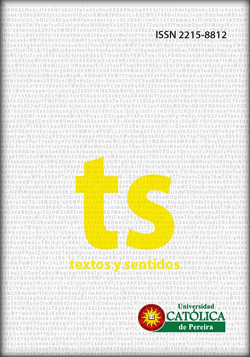Modulación estrogénica de la toma de decisiones arriesgadas
Palabras clave:
Riesgo, marcador somático, Iowa Gambling Task, Ciclo menstrual, estrógenoResumen
La toma de decisiones es un proceso que puede estar influenciado por el aprendizaje emocional, estados fisiológicos y experiencias propioceptivas. Así, los niveles de estrógeno pueden afectar la elección de opciones riesgosas. Para comprobar esto, se registró la propensión al riesgo con la tarea “Iowa Gambling Task”, en un grupo de 9 estudiantes universitarias, entre los 18 y 28 años, durante las tres fases del ciclo menstrual. Se encontraron diferencias signifi cativas (p <0, 01) en el porcentaje de elecciones riesgosas en los primeros bloques de la tarea en la fase ovulatoria. A pesar de la variabilidad intersujeto y del tamaño de la muestra, este hallazgo indica que los niveles hormonales modulan el aprendizaje emocional o la aversión al riesgo.
Referencias
Bahena -Trujillo, R., Flores, G., Arias-Montaño, J. A., & de Puebla, P. (2000). Dopamina: síntesis, liberación y receptores en el Sistema Nervioso Central. Rev Biomed, 11, 39-60.
Ball, P., Knuppen, R., Haupt, M., & Breuer, H. (1972). Interactions between estrogens and catechol amines III. Studies on the methylation of catechol estrogens, catechol amines and other catechols by the catechol-O-methyltransferase of human liver. Journal of Clinical Endocrinology & Metabolism, 34(4), 736-746.
Barbas , H. (2000). Connections underlying the synthesis of cognition, memory, and emotion in primate prefrontal cortices. Brain research bulletin, 52(5), 319-330.
Becker , J. B., Molenda, H., & Hummer, D. L. (2001). Gender differences in the behavioral responses to cocaine and amphetamine. Annals of the New York Academy of Sciences, 937(1), 172-187.
Bechara, A., & Damasio, A. R. (2005). The somatic marker hypothesis: A neural theory of economic decision. Games and economic behavior, 52(2), 336-372.
Bechara, A., Damasio, A. R., Damasio, H., & Anderson, S. W. (1994). Insensitivity to future consequences following damage to human prefrontal cortex. Cognition, 50(1), 7-15.
Bechara, A., Damasio, H., Tranel, D., & Damasio, A. R. (2005). The Iowa Gambling Task and the somatic marker hypothesis: some questions and answers. Trends in cognitive sciences, 9(4), 159-162.
Bustamante, J. (2001). Neuroanatomía Neuroanatomía funcional y clínica. Editorial medica Celsus.
Colzato, L. S., van den Wildenberg, W. P., & Hommel, B. (2007). Impaired inhibitory control in recreational cocaine users. PLoS One, 2(11), e1143.
Contreras Ros, D., Catena Martínez, A., Cándido Ortiz, A., Perales López, J. C., & Maldonado López, A. (2008). Funciones de la corteza prefrontal ventromedial en la toma de decisiones emocionales. International Journal of Clinical and Health Psychology, 8(1), 285-313.
Chambers, C. D., Garavan, H., & Bellgrove, M. A. (2009). Insights into the neural basis of response inhibition from cognitive and clinical neuroscience. Neuroscience & Biobehavioral Reviews, 33(5), 631-646.
Damasio, A. (2005). Descartes’ error: Emotion, reason, and the human brain: Penguin. com.
Damasio, H., Grabowski, T., Frank, R., Galaburda, A. M., & Damasio, A. R. (1994). The return of Phineas Gage: clues about the brain from the skull of a famous patient. Science, 264(5162), 1102-1105.
Domjan , M. (2010). Principios de aprendizaje y conducta: CENGAGE Learning.
Dunsmoor, J., & Schmajuk, N. (2009). Interpreting patterns of brain activation in human fear conditioning with an attentional–associative learning model. Behavioral neuroscience, 123(4), 851.
Fukui, H., Murai, T., Fukuyama, H., Hayashi, T., & Hanakawa, T. (2005). Functional activity related to risk anticipation during performance of the Iowa Gambling Task. Neuroimage, 24(1), 253-259.
Kayser , A. S., Allen, D. C., Navarro-Cebrian, A., Mitchell, J. M., & Fields, H. L. (2012). Dopamine, corticostriatal connectivity, and intertemporal choice. The Journal of Neuroscience, 32(27), 9402-9409.
Kleiner, M., Brainard, D., Pelli, D., Ingling, A., Murray, R., & Broussard, C. (2007). What’s new in Psychtoolbox-3. Perception, 36(14), 1.1-16.
Morris , J. S., Öhman, A., & Dolan, R. J. (1998). Conscious and unconscious emotional learning in the human amygdala. Nature, 393(6684), 467-470.
Puerto , A. (2005). La proyección humana de la psicobiología: Ediciones Aljibe, S.L.
Schmaj uk, N., Larrauri, J., De la Casa, L., & Levin, E. (2009). Attenuation of auditory startle and prepulse inhibition by unexpected changes in ambient illumination through dopaminergic mechanisms. Behavioural brain research, 197(2), 251-261.
Shurman, B., Horan, W. P., & Nuechterlein, K. H. (2005). Schizophrenia patients demonstrate a distinctive pattern of decision-making impairment on the Iowa Gambling Task. Schizophrenia research, 72(2), 215-224.
Silbergeld, S., Brast, N., & Noble, E. P. (1971). The menstrual cycle: A double-blind study of symptoms, mood and behavior, and biochemical variables using Enovid and placebo. Psychosomatic Medicine, 33(5), 411- 428.
Tirapu -Ustárroz, J., & Luna-Lario, P. (2008). Neuropsicología de las funciones ejecutivas. Manual de neuropsicología. Barcelona: Viguera Editores, SL, 221-256.
Wagar, B. M., & Thagard, P. (2004). Spiking Phineas Gage: a neurocomputational theory of cognitive-affective integration in decision making. Psychological review, 111(1), 67.
Witbracht, M. G., Laugero, K. D., Van Loan, M. D., Adams, S. H., & Keim, N. L. (2012). Performance on the Iowa Gambling Task is related to magnitude of weight loss and salivary cortisol in a diet-induced weight loss intervention in overweight women. Physiology & Behavior, 106(2), 291-297.

